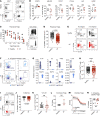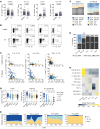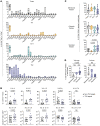Antigen specificity and cross-reactivity drive functionally diverse anti-Aspergillus fumigatus T cell responses in cystic fibrosis
- PMID: 36701198
- PMCID: PMC9974102
- DOI: 10.1172/JCI161593
Antigen specificity and cross-reactivity drive functionally diverse anti-Aspergillus fumigatus T cell responses in cystic fibrosis
Abstract
BACKGROUNDThe fungus Aspergillus fumigatus causes a variety of clinical phenotypes in patients with cystic fibrosis (pwCF). Th cells orchestrate immune responses against fungi, but the types of A. fumigatus-specific Th cells in pwCF and their contribution to protective immunity or inflammation remain poorly characterized.METHODSWe used antigen-reactive T cell enrichment (ARTE) to investigate fungus-reactive Th cells in peripheral blood of pwCF and healthy controls.RESULTSWe show that clonally expanded, high-avidity A. fumigatus-specific effector Th cells, which were absent in healthy donors, developed in pwCF. Individual patients were characterized by distinct Th1-, Th2-, or Th17-dominated responses that remained stable over several years. These different Th subsets target different A. fumigatus proteins, indicating that differential antigen uptake and presentation directs Th cell subset development. Patients with allergic bronchopulmonary aspergillosis (ABPA) are characterized by high frequencies of Th2 cells that cross-recognize various filamentous fungi.CONCLUSIONOur data highlight the development of heterogenous Th responses targeting different protein fractions of a single fungal pathogen and identify the development of multispecies cross-reactive Th2 cells as a potential risk factor for ABPA.FUNDINGGerman Research Foundation (DFG), under Germany's Excellence Strategy (EXC 2167-390884018 "Precision Medicine in Chronic Inflammation" and EXC 2051-390713860 "Balance of the Microverse"); Oskar Helene Heim Stiftung; Christiane Herzog Stiftung; Mukoviszidose Institut gGmb; German Cystic Fibrosis Association Mukoviszidose e.V; German Federal Ministry of Education and Science (BMBF) InfectControl 2020 Projects AnDiPath (BMBF 03ZZ0838A+B).
Keywords: Adaptive immunity; Fungal infections; Immunology; Pulmonology.
Figures






Similar articles
-
IgE antibody to Aspergillus fumigatus recombinant allergens in cystic fibrosis patients with allergic bronchopulmonary aspergillosis.Allergy. 2004 Feb;59(2):198-203. doi: 10.1046/j.1398-9995.2003.00310.x. Allergy. 2004. PMID: 14763934
-
Human Anti-fungal Th17 Immunity and Pathology Rely on Cross-Reactivity against Candida albicans.Cell. 2019 Mar 7;176(6):1340-1355.e15. doi: 10.1016/j.cell.2019.01.041. Epub 2019 Feb 21. Cell. 2019. PMID: 30799037
-
Immune responses to Aspergillus fumigatus and Pseudomonas aeruginosa antigens in cystic fibrosis and allergic bronchopulmonary aspergillosis.Chest. 1994 Aug;106(2):513-9. doi: 10.1378/chest.106.2.513. Chest. 1994. PMID: 7774329
-
Fungi in cystic fibrosis and non-cystic fibrosis bronchiectasis.Semin Respir Crit Care Med. 2015 Apr;36(2):207-16. doi: 10.1055/s-0035-1546750. Epub 2015 Mar 31. Semin Respir Crit Care Med. 2015. PMID: 25826588 Review.
-
Immunopathogenesis of allergic bronchopulmonary aspergillosis in cystic fibrosis.J Cyst Fibros. 2002 Jun;1(2):76-89. doi: 10.1016/s1569-1993(02)00033-4. J Cyst Fibros. 2002. PMID: 15463812 Review.
Cited by
-
An ALARMINg Type 2 Response in Cystic Fibrosis-The Key to Understanding ABPA?Am J Respir Crit Care Med. 2023 Jun 1;207(11):1418-1419. doi: 10.1164/rccm.202303-0580ED. Am J Respir Crit Care Med. 2023. PMID: 37023264 Free PMC article. No abstract available.
-
Proliferative activity of antigen-specific CD154+ T cells against bacterial and fungal respiratory pathogens in cystic fibrosis decreases after initiation of highly effective CFTR modulator therapy.Front Pharmacol. 2023 Jun 20;14:1180826. doi: 10.3389/fphar.2023.1180826. eCollection 2023. Front Pharmacol. 2023. PMID: 37408761 Free PMC article.
-
The gut-lung axis: the impact of the gut mycobiome on pulmonary diseases and infections.Oxf Open Immunol. 2024 Jul 24;5(1):iqae008. doi: 10.1093/oxfimm/iqae008. eCollection 2024. Oxf Open Immunol. 2024. PMID: 39193472 Free PMC article. Review.
-
Aspergillus in Children and Young People with Cystic Fibrosis: A Narrative Review.J Fungi (Basel). 2025 Mar 9;11(3):210. doi: 10.3390/jof11030210. J Fungi (Basel). 2025. PMID: 40137248 Free PMC article. Review.
-
Increased NFAT and NFκB signalling contribute to the hyperinflammatory phenotype in response to Aspergillus fumigatus in a mouse model of cystic fibrosis.PLoS Pathog. 2025 Feb 4;21(2):e1012784. doi: 10.1371/journal.ppat.1012784. eCollection 2025 Feb. PLoS Pathog. 2025. PMID: 39903773 Free PMC article.

